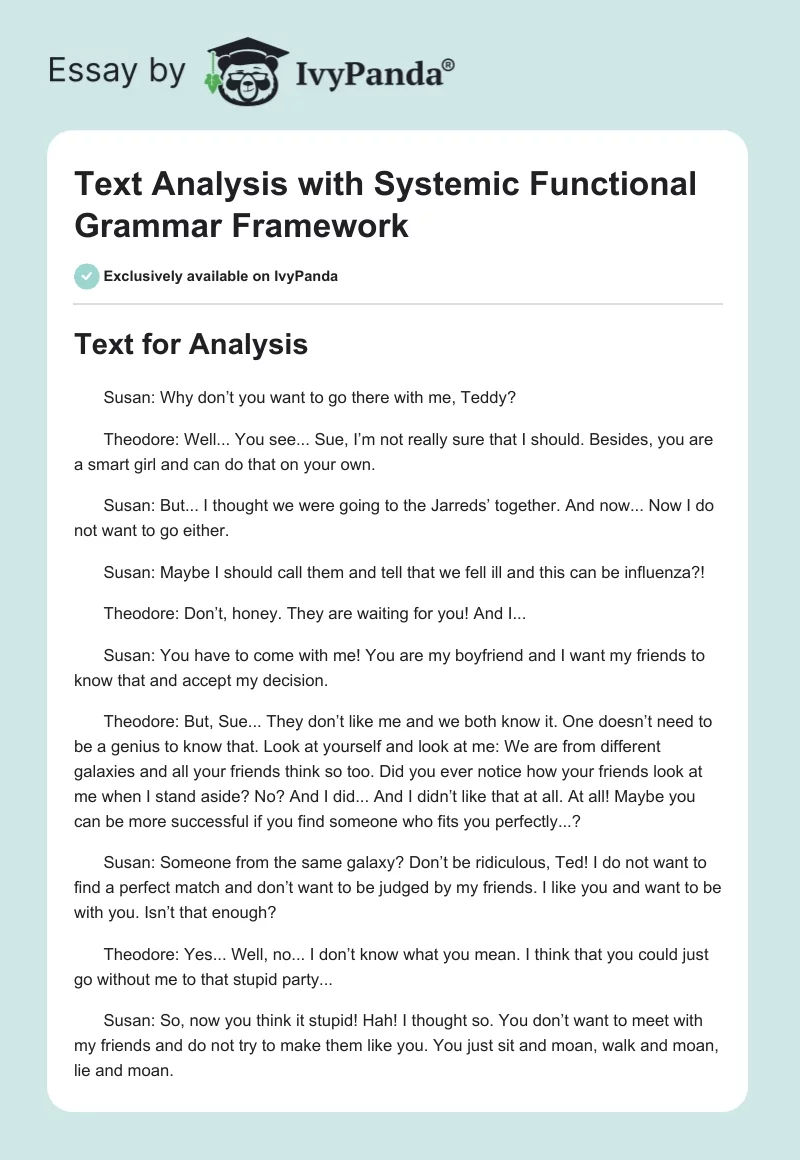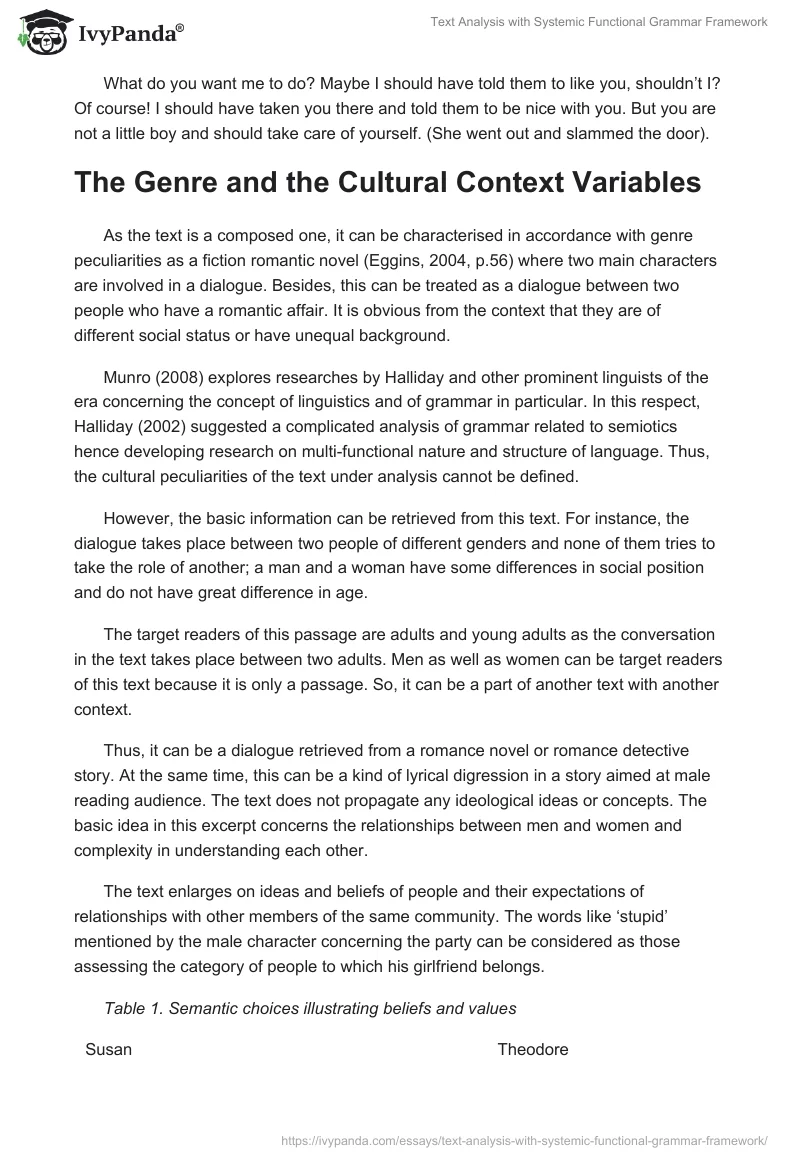Text for Analysis
Susan: Why don’t you want to go there with me, Teddy?
Theodore: Well… You see… Sue, I’m not really sure that I should. Besides, you are a smart girl and can do that on your own.
Susan: But… I thought we were going to the Jarreds’ together. And now… Now I do not want to go either.
Susan: Maybe I should call them and tell that we fell ill and this can be influenza?!
Theodore: Don’t, honey. They are waiting for you! And I…
Susan: You have to come with me! You are my boyfriend and I want my friends to know that and accept my decision.
Theodore: But, Sue… They don’t like me and we both know it. One doesn’t need to be a genius to know that. Look at yourself and look at me: We are from different galaxies and all your friends think so too. Did you ever notice how your friends look at me when I stand aside? No? And I did… And I didn’t like that at all. At all! Maybe you can be more successful if you find someone who fits you perfectly…?
Susan: Someone from the same galaxy? Don’t be ridiculous, Ted! I do not want to find a perfect match and don’t want to be judged by my friends. I like you and want to be with you. Isn’t that enough?
Theodore: Yes… Well, no… I don’t know what you mean. I think that you could just go without me to that stupid party…
Susan: So, now you think it stupid! Hah! I thought so. You don’t want to meet with my friends and do not try to make them like you. You just sit and moan, walk and moan, lie and moan.
What do you want me to do? Maybe I should have told them to like you, shouldn’t I? Of course! I should have taken you there and told them to be nice with you. But you are not a little boy and should take care of yourself. (She went out and slammed the door).
The Genre and the Cultural Context Variables
As the text is a composed one, it can be characterised in accordance with genre peculiarities as a fiction romantic novel (Eggins, 2004, p.56) where two main characters are involved in a dialogue. Besides, this can be treated as a dialogue between two people who have a romantic affair. It is obvious from the context that they are of different social status or have unequal background.
Munro (2008) explores researches by Halliday and other prominent linguists of the era concerning the concept of linguistics and of grammar in particular. In this respect, Halliday (2002) suggested a complicated analysis of grammar related to semiotics hence developing research on multi-functional nature and structure of language. Thus, the cultural peculiarities of the text under analysis cannot be defined.
However, the basic information can be retrieved from this text. For instance, the dialogue takes place between two people of different genders and none of them tries to take the role of another; a man and a woman have some differences in social position and do not have great difference in age.
The target readers of this passage are adults and young adults as the conversation in the text takes place between two adults. Men as well as women can be target readers of this text because it is only a passage. So, it can be a part of another text with another context.
Thus, it can be a dialogue retrieved from a romance novel or romance detective story. At the same time, this can be a kind of lyrical digression in a story aimed at male reading audience. The text does not propagate any ideological ideas or concepts. The basic idea in this excerpt concerns the relationships between men and women and complexity in understanding each other.
The text enlarges on ideas and beliefs of people and their expectations of relationships with other members of the same community. The words like ‘stupid’ mentioned by the male character concerning the party can be considered as those assessing the category of people to which his girlfriend belongs.
Table 1. Semantic choices illustrating beliefs and values
Description of Experiential Meanings
The most verbs are used in the function of material, behavioural, and identifying meaning hence signalling about the material nature of the conversation. There are many negations in the text that identify the inability of two people to compromise and find a sound decision.
Thus, excessive use of “want” and “should” with and without a negative particle meaning that the problems concerns expectations, ability, necessity, and desire to make some actions. The following table introduces this situation:
Table 2. Experiential meanings: Identification of processes
Description of Interpersonal Meanings, Power Relations, and Modality
The identification of participants appears to influence largely on the identification of discourse. In this respect, the main topics of concern of participants are her friends and his unwillingness to compromise.
In this respect, it is possible to suggests that this is a couple of people who are not married and who try to build their relations. There are many aspects and hidden conflicts that interfere with their feelings and true emotions.
Table 3: Participants
The text is based on interrogative and negative forms to emphasise the importance of the conflict and frequency of using mutual reproaches in the conversation. Both participants of the dialogue use incomplete sentences but the male character uses those incomplete sentences more often than the female signalling about shifted roles and her dominance on their couple.
Description of Textual Meanings and Textual Coherence
The clauses are not always organised in the way when a ‘theme’ occurs in the initial position as there are functional words in the initial position whereas a certain meaning is attributed to the initial position of a clause in a sentence. Thus, Rose (2001 as cited in Mushin & Baker, p. 34) suggests that the ‘theme’ refers to “this is what I’m talking about” while the ‘rheme’ is treated as “this is what I’m saying about it”.
The use of various types of grammar is emphasised in the study by O’Halloran (2011, p.19) where the author analyses the political debates.
Any type of conversation where more than one person is enrolled requires more complicated grammar. In this respect, the text under analysis can be characterized with the help of systemic functional grammar framework. Fawcett (2000) suggests a few principles of treating the theory of systemic grammar with a branch of syntax.
The textual interactivity of the text is very high as both characters use hesitators, pauses, and repetitions. For instance, ‘Well… You see…’, ‘And now… Now I do not want to go either’, ‘And i didn’t like that at all. At all!’, ‘Yes… Well, no… I don’t know what you mean’. Spontaneity of the text is obvious as there are many phrases with irregular structure and those where a nominal group is absent.
Even those phrases that should have been built in accordance with coordination of sentences were separated to make the text more emotionally coloured and make those pauses more meaningful. The text is coherent because it has a beginning, a climax, and a dénouement. All facts are presented in a clear way and explained by characters with the help of introduction of a conflict and mutual reproaches.
Classroom Applicability of This Text
The text can be used in the class for analysis because it has different grammatical forms, means of expression, and stylistic devices. Before introducing this text for analysis in classroom, it is necessary to discuss different situations that can occur between people that have various relationships.
It would be great to provide students with examples of situations and ask them to characterise the mood of each situation. For instance, even positive lexical units can be used in the situation marked with negative mood and vice versa. In this respect, lesson objectives and tasks can be the following:
- Read the text and assess the situation given. Try to give constructive feedback on the content of the text. Critically evaluate the actions and cues of characters;
- Analyse the characters and relations between them. Identify the level of intimacy between characters and their social distance (implicitly or explicitly shown in the text). Evaluate the usage of the words with positive and negative connotation and identify the effect produced by non-typical use of words with certain connotation;
- Identify the mood of the text (the whole text if the mood did not change in the course of the story or mood of each part if the mood changed in the story);
- Mark contacted forms and explain their meaning. Trace those cases when a contacted form is used in the same phrase as the full one. Explain such use of contracted forms and effects produced with the help of this technique. Assess the frequency of using short and full forms and emotional colouring of those cases.
Reference List
Eggins, S. (2004). An introduction to systemic functional linguistics. London: Continuum International Publishing Group.
Fawcett, R. P. (2000). A theory of syntax for systemic functional linguistics. Amsterdam: John Benjamins Publishing Company.
Halliday, M. A. K. (2002). On grammar. London: Continuum.
Munro, R. A. (2008). Probabilistic representation of systemic functional grammar. London: Endangered Languages Archive Department of Linguistics School of Oriental and African Studies University of London.
Mushin, I. & Baker, B. J. (2008). Discourse and grammar in Australian languages. Amsterdam: John Benjamins Publishing Company.
O’Halloran, K. L. (in press 2011). Multimodal discourse analysis. In K. Hyland and B. Paltridge (eds.). Companion to Discourse. London and New York: Continuum. Web.


